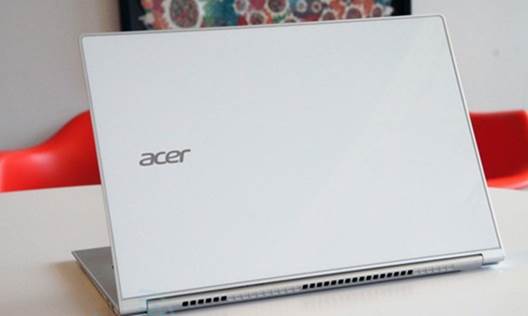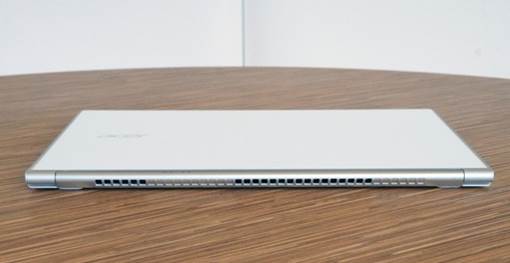When Acer first unveiled the Aspire S7
Series, there were two things that seemed worth noticing: first, they were the
company’s first touchscreen Ultrabooks, and they were best-manufactured
Ultrabooks. While the previous S3 and S5 looked somewhat tedious, the S7 is
made of aluminum, with glass lid made by Gorilla Glass or metal, depending on
whether you choose the 11-inch or 13-inch model. Moreover, it has a 1080p IPS
screen, which looks equally beautiful in our initial test as the specification
sheet would make you believe it. In addition to a choice between Intel Core i5
and i7 and SSD RAID 0 configuration, you can expect the same fast performance
that we have recognized in the S5. What is it? Is it that eventually Acer had
to build an Ultrabook that we can enthusiastically recommend to everyone?
Moreover, does the 13-inch model have everything appropriate to justify a
starting price of $1,400? Let’s find it out in our review.

Acer
Aspire S7
Style and feel
Smooth glass, sharp edges and cold
aluminum. You can forget about the reputation of the Acer producing computer
with cheap plastics: the S7 is nice to the touch as well as the look, and it is
the most beautiful laptop with touchscreen that the company has ever built. On
the 11-inch and 13-inch models, the keyboard trays are made of smooth aluminum,
with large trackpad and metal keys. Although it looks as if the screen had a bezel,
actually it is the mirror edge-to-edge screen, with the first contour
corresponding to the white lid. Obviously, when we talk about the white lid, we
are referring to the 13-inch model: that larger version has the White Gorilla
Glass cover, while the 11-inch version has a metal lid. Both look beautiful;
simply do not expect it is the reduced version of the other. Especially because
we check the glass model, we can talk about it more directly: the white surface
leaves fingerprint smudges but, as promised, it does not have any scratches.

Weighing
2.86 pounds, the 13-inch version we tested is as heavy as the Aspire S5, which
was quite light for an Ultrabook.
Weighing 2.86 pounds, the 13-inch version
we tested is as heavy as the Aspire S5, which was quite light for an Ultrabook.
It seems to be a miracle, given the S7 has a 13-inch glass lid – after all, the
last time we evaluated a laptop with a glass lid, we had to give a key reason
to justify Its fairly heaviness. The thinner 13-inch model (0.47 vs. 0.59 inch)
is worth noticing given the S5 has been advertised as the "world's
thinnest" Ultrabook. (the S5 has a motorized drop-down port door in the
back, so it must be thicker than the S7). Even if you do not have the S5 for
comparing, we think you will be able to appreciate how thin it is. It actually
feels thinner and lighter than other 13-inch Ultrabooks. And again, the S7 has
a disadvantage in that the glass lid and the touchscreen add more weight
theoretically. But that is a good job, Acer!
At the bottom, the laptop is sealed in such
a way that you cannot easily access the battery, the SSD or RAM. (This is
fairly typical for an Ultrabook). The lower surface is also the place where you
will find a range of loudspeakers, which is a little unusual: the laptop
speakers are usually placed on or around the side of the keyboard area. The
space next to the back of the machine completely is occupied by the air vents,
which will make its presence known regularly (we'll talk more when it comes to
performance).
Regarding ports, the S7 offers almost everything
you expect in a 13-inch Ultrabook: two USBs 3.0, one 3.5mm headphone jack and one
SD reader. (We just expected an Ethernet jack on thicker systems). One thing
you may want but will not have is a large HDMI jack; only a micro version is
available here. However, you have USB-to-Ethernet and micro-HDMI to VGA adapters,
along with a bag and mouse, so hopefully you will not have any discomfort.
Keyboard and trackpad

Keyboard
Our test unit has a layout that customers
in Canada will see, but that does not mean our thoughts on the backlit keyboard
will not resonate with customers in the United States. As we found with two
other Acer Ultrabooks, the keys are flat and shallow, which does not provide
much movement. Meanwhile, the real size of the buttons is a mixture: the Caps
Lock key has the size of the nail on your finger, but the Enter and Backspace
keys have bigger space. In any case, any consideration that Acer has introduced
into the design of the keyboard seems to have been compensated: we quickly typed
with high-speed, with very few mistakes. And when we make mistakes, the oversized
Backspace key is so easy to press.
The trackpad’s story is quite appropriate
with what we've seen from some other new Windows 8 laptops: it makes it possible
for the processing of natural gestures of Windows 8, but not as good as a
finger navigation. For example, you will not encounter problems in swiping from
the right to bring up the Charms Bar; which is a strategy that really does not
require a lot of practice. When it comes to dragging the cursor around the
screen, the arrow usually stops before you get over anything you click. Other
times, the touchpad recognized a left click when all we were doing was moving
the cursor around the screen. We encountered similar problems while performing pinch-to-zoom
(although it was a quite smooth zoom). So, if we are not careful, we
accidentally open applications when not intending to do so. The good news is
that the computer responds very quickly when we hit the Start button as a way
to retreat.